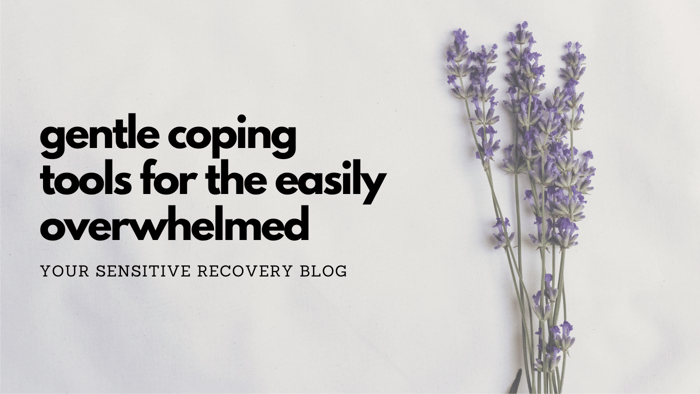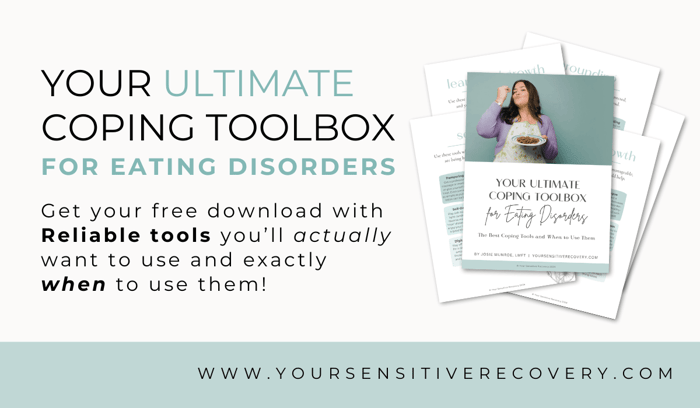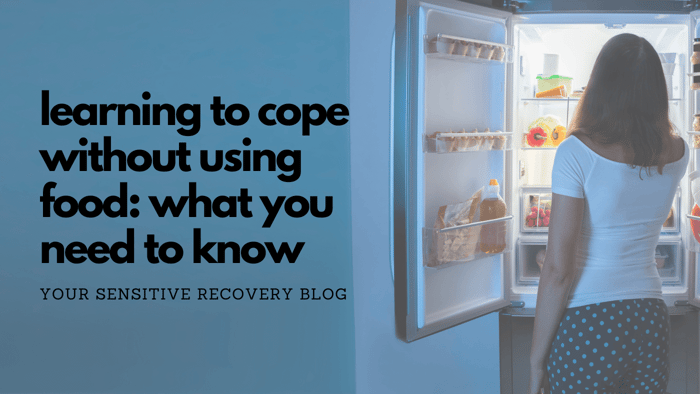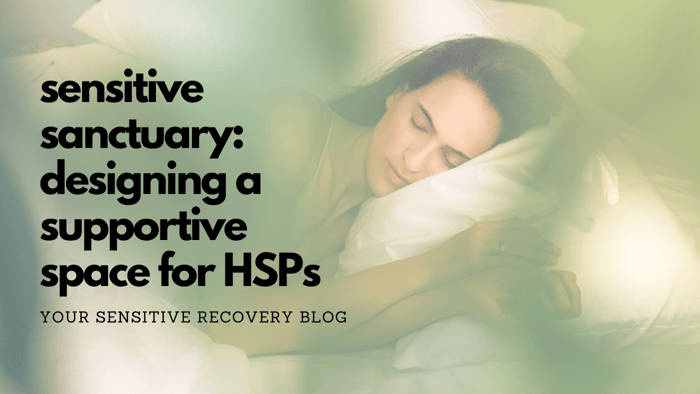With the internet, AI, and an endless stream of TikTok mental health influencers at your fingertips, it might seem like good coping tools are everywhere. But for sensitive folks, finding the ones that are actually helpful (tools that feel effective, enjoyable, and easy to use) can be surprisingly tricky.
When you're easily overwhelmed, having the right tools isn’t just nice; it’s essential for creating a more balanced, joyful life. That’s where I come in.
I’ve curated a list of my favorite coping tools for Highly Sensitive People.
These aren’t just any tools - they’re the ones that can help you find calm, reduce stress and overstimulation, and move through life with more ease.
If you're ready to find your 😌 "ahhh," let's dive in.
Sensory-Based Coping Tools
As a Highly Sensitive Person, your nervous system picks up on everything, so your senses can be a source of both joy and overwhelm. Sensory-based coping tools help you regulate your environment and soothe overstimulation, bringing you back to a place of calm and comfort.
- Have a Cuppa: A warm cup of tea can be a simple but powerful sensory tool, offering both physical and emotional comfort. I love Chamomile, Peppermint, and Lemon-Honey.
- Citrus Delight: Explore a citrus fruit like you’ve never encountered one before. Notice the texture as you roll it around in your hands. Breathe deeply as you take in the aroma. Pay attention to the explosion of taste upon your first bite.
- Auditory Support: Loud or sudden noises can be overwhelming for HSPs, making it hard to focus or relax. Try noise-canceling headphones or earplugs for relief As a true HSP, I'm particular about my earplugs and have found that this brand works well for me.
- Aromatherapy: Use an essential oil diffuser to add a positive shift to the atmosphere. Experiment with different scents for calming or invigorating responses.
- Gentle Nature Walk: Take a mini escape to a place in nature and let it fill your soul. Be on the lookout for the imperfection in the beauty around you. As HSPs, we spend a lot of time trying to shut out overwhelming sensory information. In nature, we don't have to do that.
- Weighted Blanket: The gentle, even pressure of a weighted blanket, lap pad, or stuffed animal can feel like a calming hug for your nervous system, reducing anxiety and promoting relaxation. Experiment to find the right weight for you.
- Textured Objects for Fidgeting: Engage your sense of touch with smooth stones, stress balls, or textured fabrics. These small, portable tools can help redirect excess energy.
Emotion-Regulation Coping Tools
HSPs feel deeply, which can be both a beautiful gift and a challenge when emotions become intense. Emotional regulation tools support you in processing and expressing your feelings in a way that feels grounding rather than overwhelming.
- Have a Cry: Tears are a natural (and essential) way for your body to process and release emotions. Instead of holding them back, allow yourself to cry whenever possible. Crying is 100% normal and ok! Although you may fear you'll never stop, I promise that you will.
- Free-Flow Journal: Set a timer for 5 minutes and just write. Don't stop to think - just let your thoughts flow and write as quickly and as messily as you need. Destroy after if desired.
- Shred It: I love this tool when I'm angry or frustrated. Rip up a few sheets of paper. Go for the smallest shreds possible. Let it rip! (For extra oomph, try snapping dead twigs!)
- Dear Fear: Imagine that Fear is a person. Perhaps a sweet, young child. Write them a letter.
Share whatever you think they need to hear. Let them know how you understand them and will be there for them through this challenging moment.
RAIN Meditation: This practice helps you gently sit with and explore challenging emotions.
First, recognize what’s going on inside and name it. Allow the experience to simply be what it is, then investigate it with kindness. With Non-attachment, experience the emotion without becoming it.- Worry Box: Whenever you experience a worry, write it down and place it in a special container. From time to time, look through it and remove the worries that have been resolved or no longer apply. This is such a great way to see how often things take care of themselves.
Ball of Energy: If you're wrestling with a difficult emotion, visualize it as a ball of energy. First see it in your body - where it is, what color it is, Then, see it begin to shrink and dissolve, or maybe float out and away from you.
Grounding Coping Tools
When life feels like too much, grounding techniques help bring you back to the present moment. These coping tools reconnect you to your body and surroundings so you can feel more stable and secure.
- Ice Cube: Hold an ice cube and gently move it around over your arm or leg. Pay attention to the temperature changes as you do so. You may wish to wrap the cube in a paper towel.
- Earthing: Place your bare feet on grass, sand, or soil. Visualize your connection to Mother Earth and the transfer of energy with her. Many HSPs find this practice deeply soothing.
- P.A.T.H.: Sitting quietly, bring your awareness to where on/in your body you feel the following sensations. Pressure (maybe where your legs meet your chair?), Air (your cheeks or backs of your hands?), Tension (shoulders or jaw tight?), and Heat (from your hair on your neck?).
- The Beat: Use an external speaker if possible to play a song with a strong, steady bass beat. Lie on the ground next to the speaker & focus on the reverberations in your body.
- Oasis Spot: Scan your body for a location that feels totally neutral, or maybe even comfortable. Rest your attention on this area for however long you’d like. (The tip of your nose is often a great place to try.)
- 5-4-3-2-1: This simple exercise helps bring you into the present. Around you, identify 5 different colors you see, 4 textures you feel, 3 things you hear, 2 things you smell, and 1 thing you taste.
- Humming: The vibrations from humming activate your vagus nerve. This can be incredibly grounding and can even create a sense of joy or lightness after a while.
Cognitive Coping Tools
Your thoughts profoundly impact how you feel. Cognitive coping tools help shift unhelpful thought patterns, reduce anxiety, and cultivate a more compassionate, balanced mindset. No toxic positivity, here.
- Dialogue: Write out a conversation between an activated part of yourself (maybe Anxiety, or Loneliness), and your Self with a capital S. (Self is the integrated, healthy you that you can access when supporting other people.) Make sure you always let Self have the last word.
- Fact-Checking: If you catch yourself in a spiral, pause and ask, "Is what I'm thinking a fact or is it a story I'm telling myself? Do I have evidence either for or against this thought?"
- Leaves on a Stream: Instead of getting overly attached to a distressing thought, visualize the thought as a leaf landing in a stream and floating away from you and out of sight.
- Defusion: By simply adding a defusing phrase to the beginning of a thought, you begin to separate from it, and reduce its power. Instead of, "I am always going to be alone," try, "I notice I am having the thought that I am always going to be alone." More on this tool here.
- Progress Report: Write a list of ways you’ve made progress throughout your life. Notice both large and small achievements and moments of pride. This helps shift us out of our natural negative bias and let's us see the truth - that we are always learning and growing!
Distraction Coping Tools
This might be my favorite category of coping tools. Let me be clear: distraction is a legitimate kind of tool. Just make sure that it's not the only kind you use. Sometimes all you have energy for is something distracting. And for those times, let that be completely ok.
- Dinner Party for 1: Play nice music and light some candles. Cook (or order) your favorite meal and eat it on the “nice” dishes. Savor and enjoy your company like your good friends would.
- Play with a Pet: If you have a furry (or feathery) friend, spending time with them can be a wonderful way to shift focus and boost joy. You can always watch cute animal videos for a similar hit of lighthearted delight.
- Puzzles: Jigsaw puzzles are one of my favorite tools and never fail to calm me down. If needed, play music or listen to a podcast while you puzzle for extra distraction power.
- Coloring Books: Time to let your inner child have some creative fun. Check out coloring books for adults that are super detailed for an extra challenge. Experiment with different mediums. Perhaps you like gel pens or prefer colored pencils.
- Playlist: Let's go, Maestro! Create a playlist for a particular mood, an upcoming trip, or for a certain loved one. You may discover a new favorite song while you're at it!
- Burrito Me: Have a loved one tuck you in tight under a blanket (like a burrito) and pop in your favorite, nostalgic movie or TV show. Snuggle down and relish the safety and comfort. If needed, you can also tuck yourself in. Nothing wrong with that.
How to Choose the Right Coping Tools for You
When it comes to coping tools, there’s no one-size-fits-all approach.
What works beautifully for someone else might not feel quite right for you. The key to finding the right tools for you is to experiment, stay open, and notice what genuinely helps you feel calmer, more grounded, and more at ease.
Let go of the pressure to use a tool just because it “should” work.
If something doesn’t feel good or helpful, you don’t have to force it. However, when possible, I do think it's worth giving a new tool a few chances before deciding that it isn't a fit. Just like with actual tools, different situations call for different approaches, so be sure to pull tools from different categories.
Good, healthy coping tools usually do not completely eliminate distress.
If your tool is taking you from a 10 to a 0 in terms of distress level, that might be a sign that you're using an unhealthy tool (think drugs or alcohol). Good coping tools will ideally bring you a moderate amount of relief from distress and/or help you gain useful insight so that you can adjust your behavior if indicated. The goal is not necessarily just to feel better. The goal is to be better, as in to heal and take care of ourselves.
Above all, trust your sensitive intuition to choose tools that truly support you.
You're worth it, friend. 💕
✨ Josie Munroe, LMFT is a licensed therapist and owner of JosieMunroe.com and Your Sensitive Recovery. As a recovered clinician and Highly Sensitive Person, she loves supporting others on their journeys to form new, empowered relationships with food, their bodies, and their sensitivity. Join the newsletter for a weekly boost of hope and inspiration. You deserve a recovery that works for you! ✨






